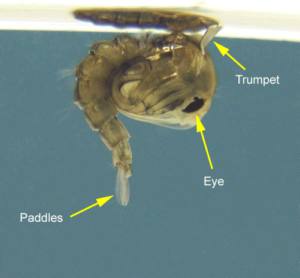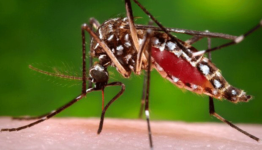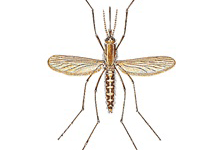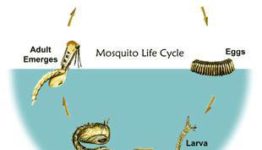Mosquitoes are one of the many creatures out there with incredibly short lifespans. It takes just days for a mosquito to go from egg stage to adult stage and eventually death. If environmental conditions are favorable, the male mosquito would live to a week while the female can lasts months. That’s where all the good news ends. This blood sucking, disease carrying insect has for a very long time constituted nuisance to humanity. The University of California-Davis Mosquito research program estimates that mosquitoes have been around for over two hundred million years now. Their wings can only carry them within a few range, meaning they spend the most of their short life span within where they were hatched. Apparently, mosquitoes have no other aim but to keep reproducing in their numbers. On the average, the female mosquito produces 500 eggs before kissing life goodbye.
When a raft of mosquito eggs look like a speck of dirt
Mosquitoes love the appearance of standing water, and will always come to breed whenever they find one. So, if you have got one around your home, be prepared to welcome them – not unless you live in Antarctica. Without water, there is no way a mosquito egg would develop. You will always find rafts of mosquito eggs on the surface of a water body that has been left to stand for a week or two. Even the water contained in an old tire would serve as an excellent breeding ground. Scientist have documented over 3,500 mosquito species. Of this number, 176 live in the United States. The Culex pipiens is the commonest of them. Female Culex mosquitoes when they lay their egg do so in batches, and each batch contains between 50 and 100 eggs which they lay on the surface of the water. This eggs would then cluster together to form a single unit known as rafts. Rafts can be easily spotted in broken containers, tree holes – just about anything that can hold water. Some species lay their eggs on wet soils in hope that their eggs would be covered in water whenever it rains. Mosquito eggs can survive even the harshest of winters and will stay intact until it rains. Mosquitoes are mostly active during the nights, and it is also during this time that the female mosquito prefers to lay her eggs. Researchers have determined that freshly laid mosquito eggs are white in color after which they would darken after a couple of days. It takes between 1 and 3 days for a mosquito egg to hatch – temperature is a determining factor. A mosquito egg laid on the ground can stay alive for a year pending then it rains.
The problem of Mosquito Larvae
Baby mosquitoes are known as larvae. They live mostly on water and source their meals from tiny bacterial organisms. Some species of mosquitoes have cannibalistic tendencies, and would feed on each other. At larvae stage, the mosquito spends most of its time in an upside down position on the surface of water. Mosquito larvae have been dubbed “wigglers” due to their ability to wiggle fast through water. Larvae stage is the mosquito’s most vulnerable stage. Birds and certain type of fishes enjoy feasting on mosquito larvae. Australian researchers have dubbed larvae the “hairy maggot with siphons”. Temperature play an important role in the development of mosquitoes because mosquitoes need some form of heat for their body to develop. The higher the level of heat, the shorter time it would take for the larvae to develop. It takes roughly a week for a larvae to develop. A mosquito goes through 4 stages of molting before reaching adulthood. Each molting stage is known as instars. On reaching adulthood, the mosquito would measure about a quarter of an inch in length.
Mosquito pupae
Otherwise known as “tumblers”, mosquito pupae feeds on nothing at this stage. The only thing they do with their time is to float through water. When likened to humans, the pupae stage is more like the adolescent stage. Mosquito pupae can be easily identified by their curved and short body, and as well as a large head. At its tail is a set of flippers which it uses to propel itself through water. Their extreme lightweight makes it easy for them to seamlessly float on water. Their body is equipped with an organ called “trumpets” which it uses to breathe”. Whenever it senses danger, the mosquito pupae would dive deep into the water before then resurfacing. Birds, fishes and even humans are their nightmares. The easiest way of snuffing life out of the pupae is by pouring oil on the surface of water. That would be their end because they won’t be able to breathe. If environmental conditions are favorable, it takes just 4 days for the pupae to become a fully realized adult. After completing the pupae stage, the mosquito would use a mix of air pressure and force to set itself free from its cocoon. The newly hatched mosquito will have to wait out on the surface of water while its wings dry and its body harden. After this brief wait, they are ready to come suck your blood.
through water. When likened to humans, the pupae stage is more like the adolescent stage. Mosquito pupae can be easily identified by their curved and short body, and as well as a large head. At its tail is a set of flippers which it uses to propel itself through water. Their extreme lightweight makes it easy for them to seamlessly float on water. Their body is equipped with an organ called “trumpets” which it uses to breathe”. Whenever it senses danger, the mosquito pupae would dive deep into the water before then resurfacing. Birds, fishes and even humans are their nightmares. The easiest way of snuffing life out of the pupae is by pouring oil on the surface of water. That would be their end because they won’t be able to breathe. If environmental conditions are favorable, it takes just 4 days for the pupae to become a fully realized adult. After completing the pupae stage, the mosquito would use a mix of air pressure and force to set itself free from its cocoon. The newly hatched mosquito will have to wait out on the surface of water while its wings dry and its body harden. After this brief wait, they are ready to come suck your blood.
When they are ready to mate
Adult mosquitoes can be easily identified by their two large eyes, a thorax, two set of wings, and three pairs of legs. Like most other insects, they possess a proboscis and antennae. The only language the male mosquito understands when it finally emerges from its cocoon is to mate and feed. It takes the adult mosquito a couple of days between emerging from their cocoon, waiting for their reproductive organ to develop (the males) and mating. They find ready to mate females by taking note of the sound produced by their wings. On locating a female, the male mosquito would release his sperm into the female, and their life cycle continues.The male mosquito barely lasts for five days, mating just once in its entire lifetime. The female outlives the male, and depending on environmental conditions can live up to a month or more. Out there in the wild, mosquitoes have to battle it hard with predators like birds and bats. Humans hate them and would use any available technique – spraying of pesticides, use of zappers and a host of others to kill them. Though capable of flying up to a distance of five miles, mosquitoes are generally short distance flyers, and prefer maintaining low altitudes while in flight to avoid being carried away by the wind.
Blood sucking female mosquitoes
Mosquitoes don’t source their diet from human blood. Plant nectar serve as food for them. It is only the female mosquito that feeds on blood and she does so to produce eggs. Due to their nocturnal nature, the female mosquito only hunts for blood at night. The annoying buzz you hear every night when the light have been turned off, 99% of the time is coming off the wings of mosquitoes. To locate their host, the female mosquito would track the carbon dioxide coming from us, as well as the lactic acid contained in the sweat coming from our body. They can easily pick up this signal from a distance of 100 feet. To draw blood, the mosquito would push its proboscis into the skin of its host. To make the blood flow easily and the host feel no pain, the mosquito would first inject an anti-coagulant. The mosquito would then draw blood way bigger than her body weight. The blood they draw from you is what they would use to prepare their eggs. Some people erroneously believe that mosquitoes feed on the blood they draw while in actual truth they only need it to prepare their eggs. After filling her tank, the female mosquito would then fly off to safety, mostly on the surface of an undisturbed water and wait for her eggs to mature. This waiting period lasts between 4 and 5 days. After laying the first batch of eggs, off she goes again to find fresh blood.
Female mosquitoes only needs to mate once to lay as many as 300 to 500 eggs in her entire lifetime. She lays about 100 eggs every other 3rd night and usually lays 3 batches before kissing life goodbye. The eggs when they hatch continues breeds another generation of blood sucking mosquitoes, and the cycle continues.










